850 Presentations
ADVANTAGES FROM “DO-IT-YOURSELF” LOOPS AMONG CHILDREN AND ADOLESCENTS AT VARNA’S DIABETES CENTER
Abstract
Background and Aims
In the last 5 years usage of automatic insulin delivery systems is increasing among patients with T1D. It has been shown that they improve metabolic control, decrease time spent in hypoglycemia and episodes of nocturnal hypoglycemia, increase time spent in target and are feasible and safe.
Aim: To evaluate benefits in children/adolescents using do it yourself (DIY) unapproved loops vs sensor-augmented pump therapy (SAP).
Methods
A total of 43 families with child/children with T1D on pump treatment and continuous use of CGM were invited to participate in the study;31 (72.1%) families accepted.The children were followed for 196 patient months.
Results
The study group consists of 31 children with T1D;24 of all are on SAP;7 use DIY loops. No differences were observed in both groups for age, duration of diabetes and daily insulin dose(Tabl.1) Patients on DIY loops spent significantly more time in range(83 vs 68.8%,p=0.02),less time in hyperglycemia above 14 mmol/l (2.1vs 8.6%,p=0.02) and have better HbA1c at 6th month(6.5 vs 7.2%,p=0.006 ) vs SAP patients for the follow-up period.No severe hypoglycemia and DKA occurred.There are no gender differences between and within both groups.
Tabl.1
| SAP | DIY loops | ||
| Age,y | 9.1±2 | 10.1±2 | NS |
| Duration T1D,y | 4.9±2 | 5.0±1.7 | NS |
| Insulin dose(U/kg/d) | |||
| initial | 0.83±0.2 | 0.76±0.2 | NS |
| present | 0.75±0.2 | 0.79±0.2 | NS |
Conclusions
DIY unregistered loops systems show promising results for better metabolic control without increasing the risk of severe hypoglycemia and DKA at least in terms of mean BGLs. Further impact e.g. consumed fat/protein, insulin dose,macro- and microvascular complications,etc.,remain to be studied in larger and longer studies.
AUTOMODE EXITS IN COMMERCIALIZED HYBRID CLOSED-LOOP SYSTEM
Abstract
Background and Aims
Hybrid closed-loop systems automatically deliver insulin based on sensor data. MiniMed 670G system operates in Auto Mode but exits to Manual Mode for certain reasons. The aim was to evaluate the duration, frequency and main reasons for exit from Auto Mode to Manual Mode.
Methods
Patients with type 1 diabetes using hybrid closed-loop system (Medtronic MiniMed 670G) for 3 months were evaluated. 2-week downloads were analysed to assess all the Auto Mode exits during this period of time.
Results
Data from 58 patients were included, age: 28 ± 15 years (7-63), 59% (n=34) females, diabetes duration: 15 ± 9 years, HbA1c: 7.0 ± 0.6%, TIR (70-180 mg/dl): 73 ± 9%.
Sensor use was 86 ± 13%. Time in Auto Mode was 85 ± 17%. Number of exits was 4 ± 2 per week (0.6 ± 0.3 per day). 16.8% of the exits were not explained. Sensor issues caused the majority of explained exits (39%), followed by hyperglycaemia (23%), auto mode disabled by user (16%) and maximum or minimum insulin delivery (13%). Frequency of exit reasons is shown in Figure 1.
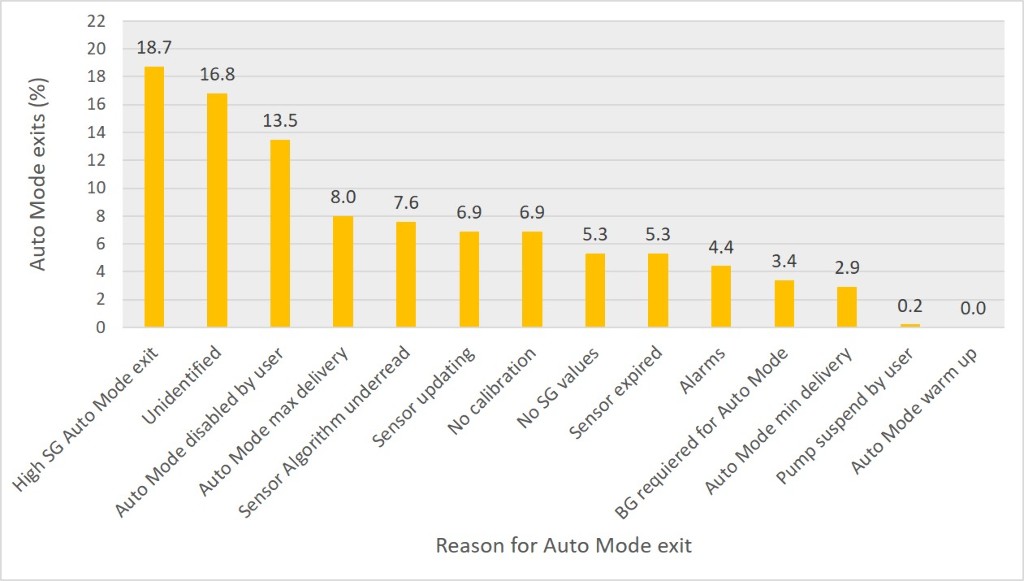
Conclusions
MiniMed 670G hybrid closed loop is maintained in Auto Mode during a high percentage of the time. The main reasons for exit to Manual Mode are sensor related, followed by high sensor glucose. A high percentage of exits are not explained. Time in Auto Mode should be maximized to improve the efficacy of the system and to avoid the burden of frequent interaction with the system for people with type 1 diabetes.
REAL-TIME BOLUS ASSISTANT FOR DIABETIC PATIENTS USING INSULIN
CREATE (COMMUNITY DERIVED AUTOMATED INSULIN DELIVERY): RANDOMISED TRIAL COMPARING AUTOMATED INSULIN DELIVERY (ANYDANA-LOOP) USING OPEN-SOURCE ALGORITHM, WITH SENSOR AUGMENTED PUMP THERAPY IN TYPE 1 DIABETES
Abstract
Background and Aims
Commercialised automated insulin delivery (AID) systems have demonstrated improved outcomes in type 1 diabetes (T1D), however they have limited capacity for algorithm individualisation, and can be prohibitively expensive if there is no access to health insurance or health funding subsidy. Freely available open-source algorithms with the ability to individualise algorithm parameters paired with commercial insulin pumps and continuous glucose monitoring make up the “do-it yourself” (DIY) approach to AID. Limited data on the DIY approach have shown promising results, but data from a large randomized control trial are lacking.
Methods
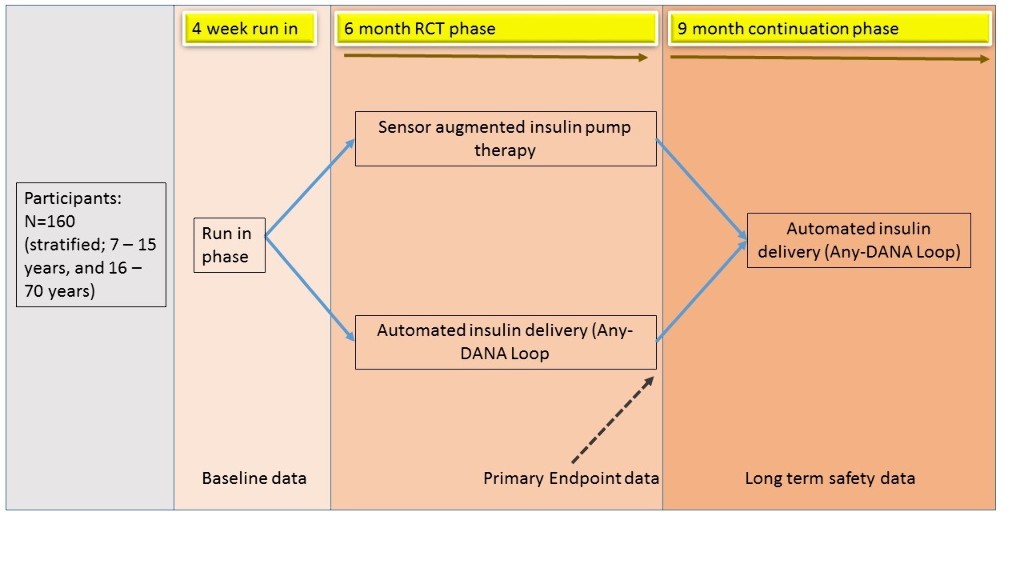
The CREATE trial is an open-labelled randomised parallel 6-month multi-site trial comparing the Android Artificial Pancreas System algorithm paired with the DANA-I insulin pump (SOOIL, South Korea) and Dexcom G6 (DexCom, San Diego) continuous glucose monitoring system (together named AnyDANA-Loop), compared to sensor augmented pump therapy. Participants (n=160) with T1D aged 7 – 70 years (age stratified into children/ adolescents 7 – 15 and adults 16 – 70 years), will be recruited from four sites in New Zealand.
Results
The primary outcome will be the time in sensor glucose range (3.9 -10mmol/L). A 9 month continuation phase follows to assess long-term safety (see figure). Secondary outcomes include psycho-social factors and platform performance. Analysis of online collective learning, characteristic of the DIY approach, is planned.
Conclusions
This study is funded by the Health Research Council New Zealand, with hardware support from SOOIL and DexCom. The CREATE trial will be prospectively registered and first participants are expected to be enrolled February 2020.
ADAPTIVE PERSONALIZED MULTIVARIABLE AP WITH PLASMA INSULIN CONCENTRATION ESTIMATION AND LEARNING OF UNANNOUNCED PHYSICAL ACTIVITIES AND MEALS
Abstract
Background and Aims
Most physical activities increase the risk of hypoglycemia for people with T1D. This study assesses the performance of our adaptive personalized multivariable artificial pancreas (AP-mAP) system without any exercises and meal unannouncements.
Methods
AP-mAP utilizes model predictive control, CGM readings, plasma insulin concentration (PIC) estimates and biosignals from a wristband. A patient’s historical data is leveraged to identify daily life activities using machine learning techniques. Incorporating online learning of probable times of significant glycemic disturbances from historical data improves AP performance by proactively mitigating the effects of impending disturbances. AP-mAP parameters such as controller set-point and PIC safety constraints are proactively modified for anticipated types and periods of disturbances.
Results
Simulations with the multivariable simulator mGIPsim illustrate the performance of AP-mAP. Twenty virtual subjects were simulated for 30 days with varying times and quantities of meals and different types, intensities, and durations of physical activities. AP-mAP reduced the 30-day average of total number of rescue carbohydrates from 20 to 6 without any hypoglycemia and improved glycemic control from 68.3% to 82.4% (in 70-180mg/dL range). One subject was simulated for 120 days with randomly varying times and quantities of meals and different types, intensities, and durations of physical activities (two exercise bouts per day). AP-mAP reduced the total number of rescue carbohydrates intakes for 120 days from 494 to 191 and kept good glycemic control (~83% in 70-180mg/dL range).
Conclusions
Integrating fully automated AP with machine leaning to adapt the AP and PIC during physical activities and meals improve diabetes management.
THE PERFORMANCE OF MINIMED 670G HYBRID-CLOSED LOOP DURING REAL-LIFE PROLONGED COMPETITIONAL TRAIL RACES (MOUNTAIN MARATHONS AND HALF-MARATHONS)
Abstract
Background and Aims
There are limited reports of the performance of the Minimed 670G hybrid-closed loop (HCL) during prolonged continuous effort. The aim of this report was to assess the performance of the HCL in maintaining time-in-range and avoiding hypoglycemia during mountain trail running races.
Methods
A type 1 diabetic recreational athlete wearing the HCL system participated in two marathons and one half-marathon. Time-in-range (TIR), average sensor glucose (ASG) and hypoglycaemia were analysed during the entire races, first 2h and remaining hours (only marathons). Carb supplementation was used to prevent/treat lows and replenish energy stores.
Results
No hypoglycemia was recorded. Time-in-range for the marathons (10h47’ and 6h15’) and half-marathon (2h23’) was 83%, 79% and 19%, with ASG of 143.3 mg/dl, 143.8 mg/dl and 232 mg/dl, respectively. During the first 2h of the marathons, TIR and ASG were 68% with 153.96 mg/dl and 52% with 184.36 mg/dl, respectively. During the rest of the races, TIR and ASG were 87% with 140.64 mg/dl and 92% with 123.67 mg/dl, respectively.
Conclusions
The 670G HCL avoided hypoglycemia during all races. Longer races correlate with an increase of TIR and decrease of ASG. Race difficulty (positive level difference, speed, route) impacts the loop’s ability to maintain glycemia in range. High intensity intervals overshoot glucose levels and cannot be rapidly countered by the algorithm. Certain strategies (insulin bolus at the start of race) are required to prevent hyperglycemia resulting from the adrenalin rush at race start. The HCL dramatically reduces hyoglycemia risk during prolonged continuous physical activity while increasing TIR.
HYBRID CLOSED LOOP IMPROVES GLYCAEMIC CONTROL IN GASTROPARESIS IN TYPE 1 DIABETES
Abstract
Background and Aims
Growing numbers of UK patients have been using the Minimed 670G Hybrid Closed Loop system since European commercialisation in 2018, with clinical "real world" experience extending beyond the initial data available from initial pivotal studies. Gastroparesis is a challenging complication which makes control of glycaemia difficult even with sensor augmented pump therapy. We report here our initial clinical experience with using the 670 in a subset of people with type 1 diabetes with advanced complications including gastroparesis.
Methods
We analysed data from 6 patients (all females already using insulin pumps, aged 47 + 4, diabetes duration 27 + 3 years, laboratory HbA1c 78 + 3 mmol/mol) started on 670G system as part of our clinical service from December 2018 onwards. All had both gastroparesis and multiple other complications of diabetes including laser-treated retinopathy, nephropathy, foot ulceration, faecal incontinence secondary to autonomic neuropathy, cerebrovascular accidents and angina. Gastroparesis had remained problematic in all despite optimised care (including intragastric botox injections and pyloroplasty in one individual and insertion of a gastric pacemaker in another). We compared data from sensor augmented pump therapy immediately prior to activating automode (closed loop) with subsequent data captured during automode.
Results
Time in range (3.9 to 10 mM) increased markedly from 35 + 3 % (consistent with challenging gastroparesis) to 64 + 4% at most recent downloads (average time using 670 system 7 + 1 month).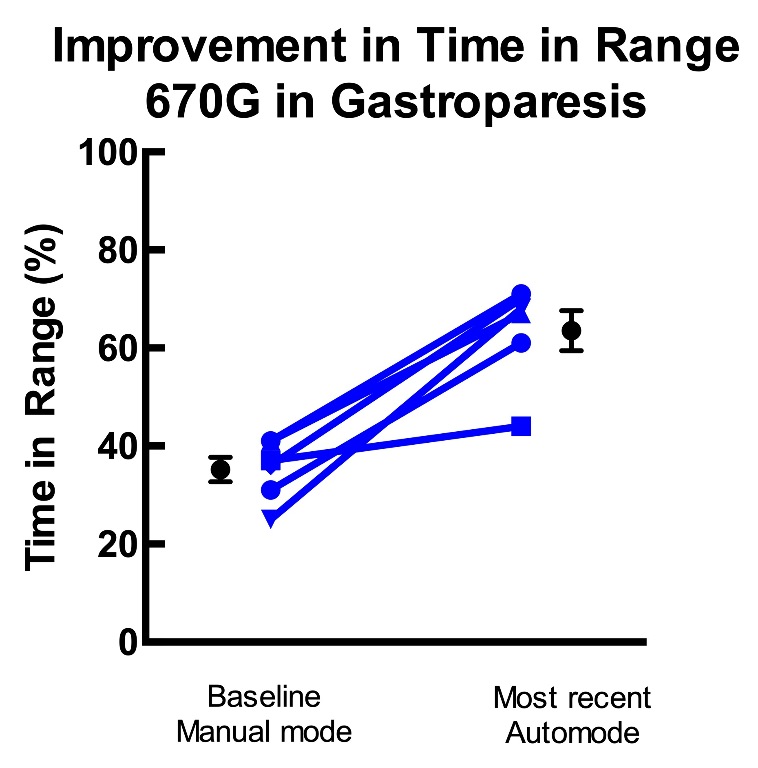
Conclusions
Hybrid closed loop insulin delivery may be extremely effective in improving glycaemic control even in those with gastroparesis and erratic glucose control.
PEDIATRIC GLUCOSE REGULATION WITHOUT PRE-MEAL INSULIN BOLUSES: AN APPROACH BASED ON SWITCHED CONTROL AND TIME-VARYING IOB CONSTRAINTS
Abstract
Background and Aims
AP systems have shown to improve glucose regulation in T1D patients. However, full closed-loop performance remains a challenge particularly in children and adolescents, since these age groups often present the worst glycemic control.
Methods
In this work, a new algorithm based on switched control and time-varying IOB constraints is presented (ARGAE). This method is a combination of ideas from the previously introduced Automatic Regulation of Glucose (ARG) algorithm, which features no pre-meal insulin boluses [1], and the Amplitude Enable (AE) mode, which allows the controller to act more aggressively at the beginning of meal intake without risking postprandial hypoglycemia [2]. The proposed control strategy is evaluated in silico and its performance contrasted with the ARG algorithm in the pediatric population.
Results
The in silico tests performed indicate that the use of the Amplitude Enable layer can help increase the time in euglycemia for both adolescent and children age groups (see tables 1 and 2). Hypoglycemia is significantly reduced in children and completely avoided in adolescents. This is an important upside of the ARGAE since a severe hypoglycemia episode is one of the most dangerous situations for people with T1D.

Conclusions
Simulations show that the proposed algorithm improves the performance of the ARG algorithm.
[1] P. Colmegna, F. Garelli, H. D. Battista and R. Sánchez-Peña, Control Engineering Practice, no. 74, pp. 22-32, 2018.
[2] E. Fushimi, N. Rosales, H. De Battista and F. Garelli, Biomed Signal Process Control, vol. 45, pp. 1-9, 2018.
ONLINE ADAPTATION OF FUNCTIONAL INSULIN THERAPY PARAMETERS IN SUBJECTS WITH TYPE 1 DIABETES MELLITUS: IN-SILICO RESULTS OF A DATA-DRIVEN METHOD
Abstract
Background and Aims
Functional insulin therapy (FIT), i.e., adjusting meal insulin to estimated meal carbohydrate (CHOmeal) and pre-meal blood glucose (BGmeal), is the recommended approach for prandial insulin dosing. However, the choice of FIT parameters (i.e., insulin-to-carbohydrate ratio [CR] and correction factor [CF]) remains challenging. Here, we propose a novel data-driven method for the online adaptation of FIT parameters.
Methods
A multi-step method was developed. A linear model of postprandial minimum glycemia (PMBG) is built, with BGmeal, CHOmeal, CR and CF as model predictors. At every meal, the model is identified using recursive least squares; simultaneously, distributions of CHOmeal, BGmeal and model error (all assumed normal) are updated. At every weekly adaptation run, optimal CR and CF are derived by minimizing the variance of PMBG, imposing 5% of PMBG values <70mg/dl. To test the method, a 10-week in-silico study was built using the UVA/Padova simulator. One-hundred virtual adults received 3 meals/day of random size, with 50% carbohydrate counting error, and meal boluses delayed up to 60min. Hypoglycemia treatments were administered at glycemia <70mg/dl. The method (initialized with random error on CR and CF) was compared to the subjects’ original FIT parameters.
Results
The evolution of glycemic outcomes is shown in the figure. At week 10, average time in 70-180mg/dl, <70mg/dl, and >180mg/dl, and number of hypoglycemia treatments/day were (original–adapted parameters): 82.6%–83.7%, 2.8%–0.4%, 14.7%–16%, and 2.3–0.3.
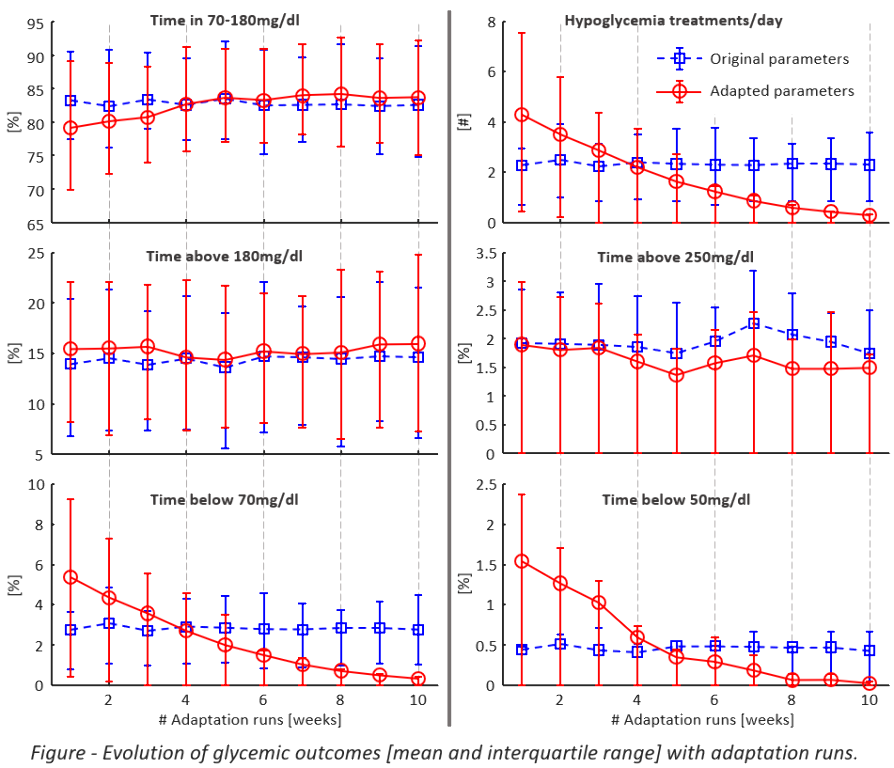
Conclusions
The novel approach to optimize FIT parameters corrects for suboptimal CR/CF and improves glycemic outcomes in a simulation environment; further studies are needed to assess its robustness for real-life applications.
FIRST ITALY DIY APS USERS SURVEY
Abstract
Background and Aims
Do-it-Yourself Artificial Pancreas Systems (DIYAPS) are becoming popular among people with diabetes of all ages and countries. We don’t have any information regarding italian situation. Aim of the study was to obtain a first photograph of the Italian loopers community.
Methods
An online survey (18 items) was distributed (July 2019) to DIY users/planning recruited through the Facebook groups Looped and OpenAPS.
Results
139 adults responded to the survey: 120 were interested in and 19 users (5 under the age of 18). The users (5 in open, 12 in closed loop) were 45% female and the mean age was 28.1±16.9, range 2-60yrs; duration of diabetes 14.7±10.6yrs. 58% of pts had been using DIYAPS for less than 6 months; 26% for over 1 year. AndroidAPS and Loop were more used than OpenAPS (8, 9 and 2 pts, respectively). Omnipod was the most used pump (50% of pts); AccuChek, Medtronic, Tandem and Dana pumps were used respectively by 25, 15, 5 and 5% of pts. 80% of pts (100% of pediatrics) used CGM Dexcom systems. The most frequent reasons for using/planning the DIY were: to improve my control, to sleep better, to have a more discreet system, usable by phone/smartwatch, to reduce hypoglycemia. Finally, the 60% of responses said that they had received a positive or neutral response from their clinic.
Conclusions
This first survey demonstrates the use of DIY systems is also spreading in Italy and that the interest of patients is rapidly increasing.
PROFILED GLUCOSE FORECASTING USING GENETIC PROGRAMMING AND CLUSTERING
Abstract
Background and Aims
This research is motivated by the challenge of creating a general method to accurately predicting future glucose levels, so, an automated or manual system can decide when and how much insulin to inject in order to maintain glucose levels within a healthy range. It is imperative to avoid predictions that may trigger unnecessary treatments or, even worse, treatments that are harmful to the patient.
Methods
The proposed methodology is a three-step process: Data collection, preprocessing, and division, Data clustering and detection of a set of glucose profiles, and, Models training, creating models by evolutionary computation. CHAID (CHi-square Automatic Interaction Detection) is applied to recursively divide the data in relation to a target variable using multiple divisions between the different input variables: days of the week and time slots. A data augmentation algorithm hat generates synthetic glucose time series is used in training datasets to develop meaningful information and significantly enhance data quality. Next, models based on Genetic Programming (GP) are created using cross-validation. Then, the best model of 10 repetitions is selected by the Akaike Information Criterion (AIC).

Results
Data was collected from ten patients. The predictors used in the construction of the tree are the day of the week and the time slot. Significant differences were observed in the glucose profiles classified for each of those categories.
Conclusions
The accuracy of predictions with models created with GP is better for shorter time horizons and gradually gets worse as the time horizon increases from 30 to 240 minutes.
Thanks: RTI2018-095180-B-I00 and Fundación Eugenio Rodriguez Pascual
GLUCOSE FORECASTING WITH RANDOM GRAMMATICAL EVOLUTION
Abstract
Background and Aims
Bolus decision is a difficult task since patients need to estimate the number of carbohydrates they are going to ingest, take into account the past and future circumstances, know the past values of glucose, evaluate if the effect of previously injected insulin has already finished and any other relevant information. In this work, we present and compare a set of methodologies to automate the decision of the insulin bolus, which reduces the number of dangerous predictions.
Methods
We combine two different data enrichment techniques based on Markov chains with grammatical evolution engines to generate models of blood glucose, and univariate marginal distribution algorithms and bagging techniques to select the set of models to assemble. Modeling is solved as four symbolic regression problems by Random-Grammatical Evolution.
Results
We report the Clarke’s Error Grid Analysis.The best results are obtained with an ensemble model developed by bagging of 100 models. For a 30 minutes forecasting horizon, all the strategies have similar performance with almost no points in the D and E zones. For the 60, 90 and 120 minutes, the best models are produced by Random-GE and Bagging with both data augmentation techniques, obtaining a 95% of safe predictions,on average.
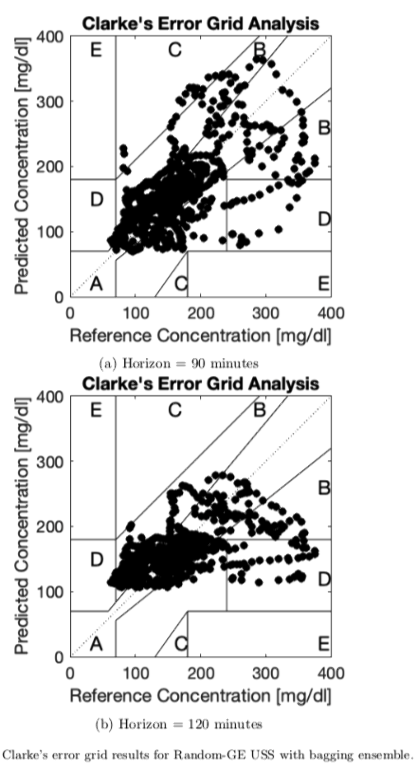
Conclusions
Results show how the methods improve results from pre-vious works. The proposal uses a simplified preprocessing process of the raw data, we use symbolic regression standard grammars and execution times are low. In future works, we should move a step forward in the forecasting horizon.
Thanks: RTI2018-095180-B-I00 and Fundación Eugenio Rodriguez Pascual
